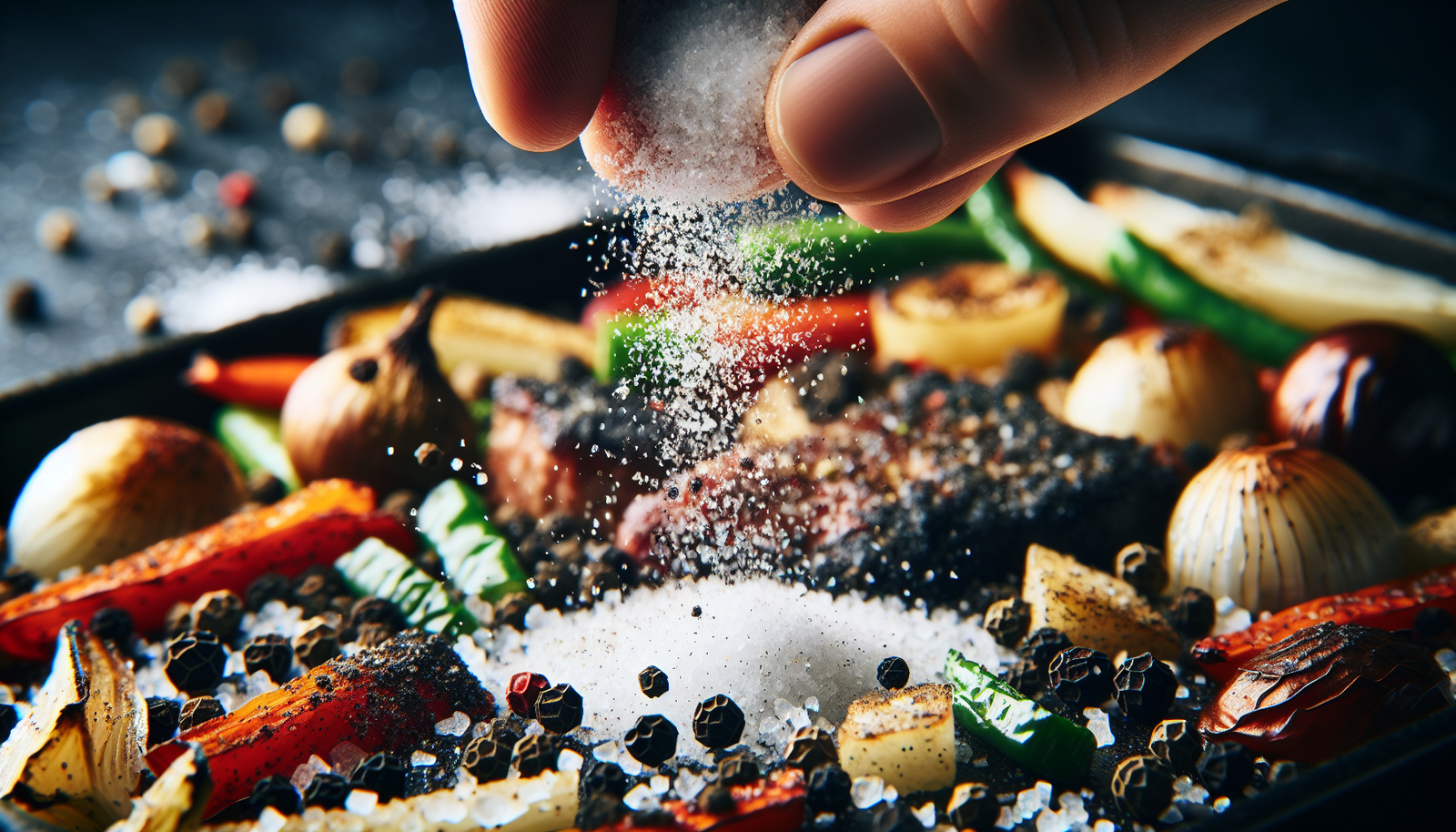
How to Use Salt and Pepper for Perfect Seasoning?
Salt and pepper are the foundation of great seasoning. They enhance the natural flavors of food when used correctly. This guide dives into the art of balancing these two essential ingredients, showing you how to use them for perfect seasoning in all your dishes.
The Role of Salt in Cooking
Salt is more than just a seasoning. It’s an essential component in cooking that transforms a dish from bland to flavorful. Understanding the types of salt and their uses, how salt enhances flavor, and salt tasting techniques can elevate your culinary skills.
Types of Salt and Their Uses
Diverse in texture and taste, different types of salt serve unique purposes in the kitchen. Table salt, with its fine granules, dissolves quickly and is perfect for baking. Kosher salt, on the other hand, is favored for its larger grains and is ideal for seasoning meats. Sea salt, harvested from evaporated seawater, boasts a minerally taste and works well as a finishing salt. Each type of salt brings its distinct qualities, enabling chefs to choose the right one for the task at hand.
- Table Salt: Best for baking due to its fine consistency.
- Kosher Salt: Ideal for seasoning meats and general cooking.
- Sea Salt: Perfect as a finishing touch to enhance flavors.
How Salt Enhances Flavor
Salt doesn’t just add saltiness; it amplifies the natural flavors of food. By reducing bitterness and enhancing sweetness, salt creates a harmonious balance in dishes. This ability to elevate flavors makes it a cornerstone in cooking. It draws out moisture, tenderizes meats, and even helps in preserving food. The chemistry between salt and food is a dynamic dance that, when done right, leads to exquisite culinary experiences.
Consider its role in reducing bitterness in green vegetables or boosting the sweetness of desserts. Salt’s power lies in its ability to make flavors pop, enhancing the overall taste profile of your dish.
Salt Tasting Techniques
Tasting salt isn’t just about adding it to your food. It’s about understanding its impact. Start by tasting a small amount of each type to distinguish their unique profiles. Notice how a pinch of sea salt can bring out the natural sweetness in a tomato or how Kosher salt can make meat juicier. By refining your palate, you’ll know precisely how much and which type of salt to use, ensuring balanced and flavorful results every time.
Engage in blind taste tests, comparing different salts on similar foods to fully appreciate their characteristics. Your taste buds will guide you to the perfect salt choice.
Using Pepper for Depth
Pepper adds complexity and depth to dishes. Whether freshly ground or pre-ground, different types of peppercorns offer varying levels of heat and aroma. Knowing how to balance these elements can transform your culinary creations.
Freshly Ground vs Pre-Ground Pepper
Freshly ground pepper brings a vibrant aroma and robust flavor to dishes, unlike its pre-ground counterpart, which loses potency over time. Fresh grinding releases essential oils, elevating the sensory experience of your food. While pre-ground pepper offers convenience, nothing beats the boldness of freshly ground pepper. For a more flavorful dish, consider investing in a pepper mill to enhance every meal with freshly cracked goodness.
Different Types of Peppercorns
Peppercorns, though small, have a significant impact on flavor. Black, white, green, and red peppercorns each bring something unique to the table. Black peppercorns are the most common, known for their heat and complexity. White peppercorns, milder and less pungent, are perfect for light-colored sauces. Green peppercorns offer a fresh, herbaceous quality, while red are sweet and fruity. Each type can be used to achieve specific flavor profiles in your dishes.
- Black Peppercorns: Spicy and complex, ideal for robust flavors.
- White Peppercorns: Milder, suitable for lighter dishes.
- Green Peppercorns: Fresh and zesty, great for sauces and marinades.
- Red Peppercorns: Sweet and fruity, perfect for creative culinary uses.
Balancing Pepper Heat in Dishes
Achieving the right balance of pepper heat can be a delicate task. Too much, and it overpowers; too little, and it gets lost. The key is gradual seasoning. Start with a small amount, taste, and adjust. Consider the dish’s overall flavor profile and the type of peppercorn used. Pairing hot pepper with creamy or sweet elements can create a pleasing contrast. Balance is essential to ensure pepper complements rather than dominates your creation.
Combining Salt and Pepper
Salt and pepper are a culinary duo that, when used thoughtfully, can transform any dish. Knowing when to add these seasonings, how to use them as finishing touches, and correcting overseasoning are crucial skills for any cook.
When to Add Salt and Pepper
The timing of adding salt and pepper can affect the final taste and texture of your dish. Salt should often be added early in the cooking process to allow it to work its magic, enhancing flavors and tenderizing ingredients. Pepper, with its volatile oils, can be added at different stages—early for depth of flavor, or as a finishing touch for a more pronounced aroma and heat. Understanding the right moment to season can elevate your cooking to new heights.
Using Salt and Pepper as Finishing Touches
Applying salt and pepper as finishing touches can refine a dish’s profile. A sprinkle of flaky sea salt or a dash of freshly ground pepper just before serving can enhance texture and flavor. These finishing touches not only add visual appeal but also a burst of taste, accentuating the dish’s natural elements. Experimenting with different types of salt and pepper can lead to surprising and delightful results.
Correcting Overseasoning
Overseasoning happens to the best of us, but it doesn’t have to spell disaster. If you’ve gone overboard with salt, adding a splash of acid like lemon juice or vinegar can help neutralize the salinity. For too much pepper, a dollop of cream or a grated potato can absorb excess heat. Adjusting with additional ingredients can restore balance, ensuring your dish remains delicious and enjoyable.
With careful attention and creativity, you can master the art of seasoning, creating meals that are both flavorful and well-balanced.
Conclusion
Salt and pepper are the backbone of seasoning, offering simplicity and depth when used correctly. With the right techniques, you can bring out the best in any dish. By understanding how to balance and layer these essential ingredients, you’ll be able to season food perfectly every time. So grab that grinder and get creative!
FAQ
What type of salt should I use for cooking?
Use kosher salt or sea salt for most cooking. These types offer great flavor and are easy to pinch. Table salt is finer and can sometimes make dishes too salty if not measured cautiously.
How do I properly season with pepper?
Freshly ground black pepper adds the best flavor. Grind directly onto the dish to control the amount. Start with a small amount and adjust to taste, ensuring even distribution.
Can I add too much salt to a dish?
Yes, over-salting can overwhelm flavors. Start with a smaller amount and taste as you go. It’s easier to add more salt than to fix an overly salty dish.
When should I season food with salt and pepper?
Season at different stages. Salt can enhance flavors during cooking, while pepper is often added towards the end for maximum aroma and taste. Taste frequently to ensure balanced seasoning.
Does pepper lose flavor when stored?
Yes, pepper loses its potency over time. Store peppercorns whole and grind them fresh to maintain flavor. Keep them in a sealed container away from light and heat.
How can I adjust seasoning if I add too much salt?
If a dish is too salty, add acidity like lemon juice or vinegar. Potatoes can also absorb some salt. Diluting with more liquid or adding unsalted ingredients can balance the flavor.











